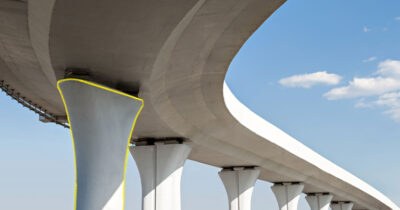RDC’s vision is to be a market leader in providing high-quality concrete solutions on time, resulting in customer delight. “The unique feature of our concrete is that it satisfies our customers with each prescribed intrinsic property of concrete at the most economical cost”, says Anil Banchhor, MD & CEO, RDC Concrete.
Innovations and cutting-edge features at RDC
We have a rigorous R&D team at the back end, continuously trying to find the most optimum material/mix to get the desired property. Ultrafine Minerals and Admixtures is the organisation that supports us in giving these properties due to the high efficiency of their materials, helping us to make concrete more durable and economical. We have demonstrated the superior performance of our concrete for critical projects where performance parameters were very high and unique. We continuously strive to mitigate the pain points of concrete consumers. Regarding the supply of concrete, most customers face issues with consistency of supply, mainly due to a gap in the plans and execution. We recently launched our RDC Trak app, which gives the location of each transit mixer fitted with GPS to the customer serving their project. As a result, our employees are more transparent and committed to our customers. Through this app, any customer can order concrete from the comfort of their home without any interaction in person. Our people are our fundamental business drivers, and their training and development help us provide the unique features of our concrete each time to our customers. We have efficiently passed on and captured our employees’ knowledge, which is critical to maintaining the standard of service and quality for every concrete we supply.
 Challenges in maintaining sustainability in concrete
Challenges in maintaining sustainability in concrete
The price is the best indicator which helps us decide whether the concrete that we supply is sustainable enough or not. The price includes the cost of raw materials, processing, transportation, and taxes. While manufacturing a product, we try to develop it at the lowest possible cost, not to capture the market but to focus on whether the product is sustainable or not. Adam Smith, one of the famous authors, rightly said in his book “Wealth of Nations” that, for the first time, a concept called “The Invisible Hand” allocates resources (scarce) efficiently. The idea of sustainability rests on the premise that resources are scarce and should be used judiciously so that our future generations do not face a shortage of these resources. Many readers have felt the connection between the Invisible Hand concept and sustainability. They have said that the closest economic indicator of the invisible hand is the “price” of the resource.
Fly ash vs OPC in terms of sustainability
Fly ash is more sustainable in construction than ordinary Portland Cement (OPC), and its cost comprises only transportation, not taxes or processing fees. The concrete made with the incorporation of fly ash is more economical and balanced than the cost of concrete made with OPC, for the same performance without any application of value engineering.
It is well-known that after reacting with water and during the hardening phase, OPC shrinks due to the densification of the phases or reduced surface tension of evaporated water. It also poses the challenges of high temperatures and cracking due to heat hydration. Concretes containing high amounts of OPC have repeatedly failed structurally due to sulphate attack, alkali-aggregate reactivity, chloride diffusivity, or lime leaching. But the requirement for strong performance is used and prescribed to the maximum possible content.
 This is where it becomes increasingly unsustainable, especially from a construction perspective. We are not supported by an OPC manufacturing company, which is why we are more sustainable. It makes us strive hard and perform better, with judicious use of cement with ultrafine mineral additives, compared to concrete from RMC organisations.
This is where it becomes increasingly unsustainable, especially from a construction perspective. We are not supported by an OPC manufacturing company, which is why we are more sustainable. It makes us strive hard and perform better, with judicious use of cement with ultrafine mineral additives, compared to concrete from RMC organisations.
Sustaining environmental efficiency through products and solutions We constantly monitor water consumption at our concrete manufacturing plants and aim to reduce it by at least 10 percent each year. To maintain clean air quality, we maintain cleanliness at our plants and constantly monitor them. We ensure more concrete is carried per unit truck per unit mile to reduce fuel consumption. As stated above, we try to minimise cement and maximise fly ash, slag, and ultrafine minerals since 1 ton of cement releases 1 ton of carbon dioxide. Also, while opening our new plants and projects, we ensure that no flora or fauna is harmed, and to recover from the harm done, we plant more trees wherever possible.
Waste management practices
According to us, the present is more affected than the future by the mantras of reducing, reusing, and recycling. We have already adopted these practices, where we are internally monitoring the minimal usage of resources and reusing wash water. In some areas, we have also started using construction demolition waste as aggregate in concrete. We reuse repaired equipment rather than purchasing new equipment because it is more environmentally friendly.
Cookie Consent
We use cookies to personalize your experience. By continuing to visit this website you agree to our Terms & Conditions, Privacy Policy and Cookie Policy.


















